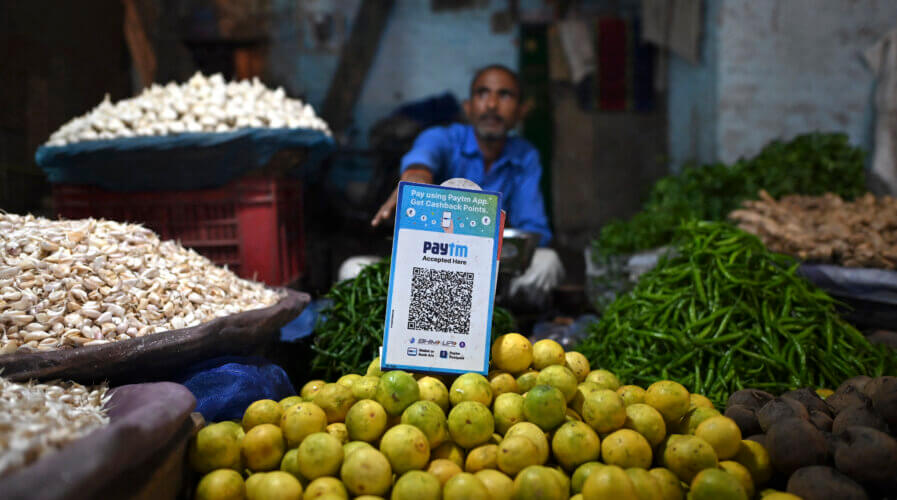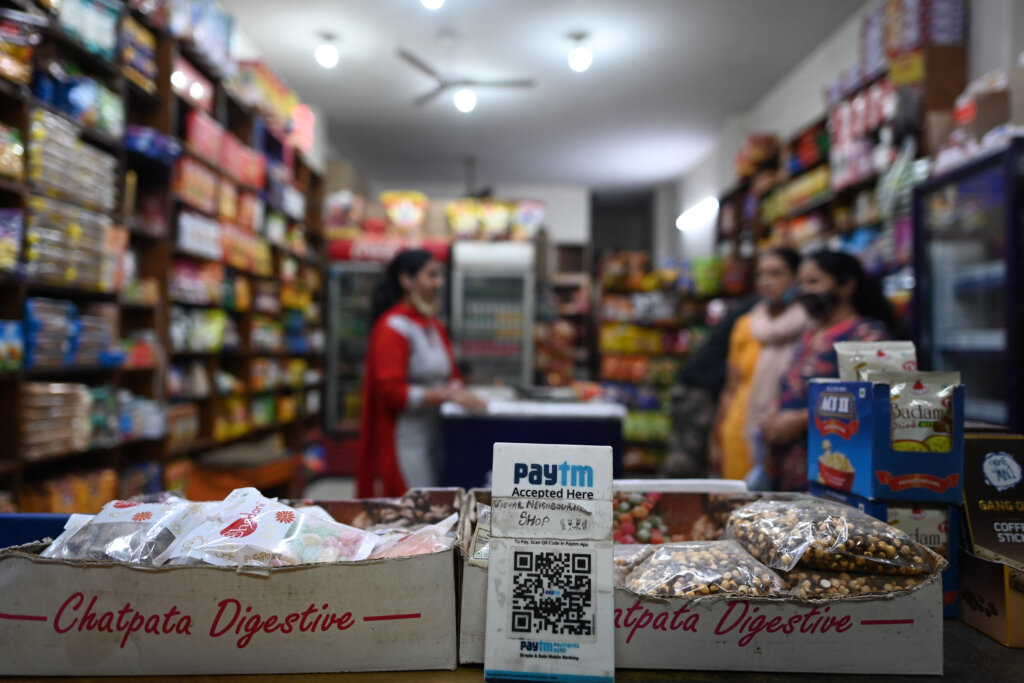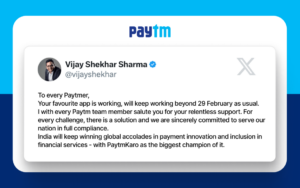
A vegetable vendor with a QR code of the Indian cellphone-based digital payment platform Paytm on display at a stall. (Photo by Sajjad HUSSAIN/AFP).
India’s Paytm is in a crisis. What do we know about the fintech giant’s turmoil?
- Paytm faces regulator scrutiny for possible questionable dealings between its banking arm and its payments app in India.
- The fintech giant also faces KYC lapses: thousands of unverified, single docs are used for many transactions to surpass limits, raising laundering concerns.
- RBI bars Paytm Bank from deposits or top-ups after February 29 and mulls license revocation in March.
Paytm, short for “Pay Through Mobile,” began its journey with a revolutionary idea – letting users make cashless transactions through their mobile phones. But it wasn’t until the whirlwind of India’s 2017 demonetization that Paytm soared to new heights. That year, Prime Minister Narendra Modi’s bold move shook up the cash-dependent economy, compelling many individuals and countless small merchants to seek alternatives. Amid the chaos, Paytm’s wallet emerged as the straightforward solution, drawing a massive influx of users.
Paytm emerged as a prime beneficiary of demonetization, witnessing a meteoric rise from 140 million users in October 2016 to a staggering 270 million by November 2017 following the demonetization program. The winds of change propelled Paytm to the forefront of India’s digital financial revolution. It has become a pioneering force, transforming how millions transact and engage with digital finance.
The platform provided a versatile and convenient solution for individuals and businesses, from small grocery purchases to utility bill payments. In short, Paytm’s success during demonetization contributed to the broader acceptance of mobile wallets in India. The platform’s simplicity and strategic marketing campaigns played a significant role in shaping the narrative around digital wallets as a reliable alternative to traditional currency.

A QR code for Paytm is pictured at a shop in New Delhi on November 8, 2021. (Photo by Sajjad HUSSAIN/AFP).
What is happening with Paytm in India now?
Founded in 2010 by Vijay Shekhar Sharma, Paytm initially gained prominence as a mobile wallet but swiftly evolved into a comprehensive financial ecosystem. Over the years, Paytm has diversified its services, expanding beyond mobile wallets to offer various financial products. The platform now provides services ranging from digital payments, mobile recharges, and bill payments to insurance, wealth management, and even digital gold investments.
This diversification has positioned Paytm as a one-stop shop for various financial needs. By 2017, Paytm received approval from the Reserve Bank of India (RBI) to launch Paytm Payments Bank, a significant milestone in its journey. The Payments Bank allowed users to open savings accounts with zero balance requirements, seamlessly integrating banking services within the Paytm app. The bank is restricted from lending and can accept deposits of up to 200,000 Indian rupees.
For context, Paytm Payments Bank is primarily owned by Paytm (One 97 Communications), with a 49% stake, while the remaining 51% is held by Paytm’s chief executive and founder, Vijay Shekhar Sharma. The bank serves as a crucial banking partner for Paytm, holding funds from popular digital wallets within its operations.
All 330 million wallet accounts under the parent company are housed within Paytm Payments Bank, making it the repository for the money held in these wallets. However, It is noteworthy to know that on top of its immense success, Paytm was not short of challenges. Most recently, in a significant setback for one of India’s largest payment firms, the RBI has directed Paytm’s payments bank subsidiary to cease accepting new deposits in its accounts or popular wallets starting in March.
So what exactly won’t be working on PayTM after 29th Feb then? 🤔 pic.twitter.com/rNJvRPAJhc
— Sunderdeep – Volklub (@volklub) February 4, 2024
According to a report by Reuters, India’s central bank said it took action because of “persistent non-compliance and continued material supervisory concerns in the bank,” which it did not specify. The restriction, effective from March 1, 2024, follows a previous limitation imposed two years ago, preventing Paytm Payments Bank from onboarding new customers.
Paytm Payments Bank was restricted from adding customers in March 2022 due to similar concerns but continued doing business with existing customers. It has been told to wind down most of its businesses this month. Moreover, local reports indicated that the banking regulator consistently raised concerns over various issues.
Sources reveal that apprehensions regarding money laundering and substantial financial transactions, amounting to hundreds of crores of rupees, between the well-known Paytm wallet and its less prominent banking arm prompted the RBI to take action against entities overseen by Vijay Shekhar Sharma.
It has also been disclosed that Paytm Payments Bank had numerous non-KYC (Know Your Customer) compliant accounts, with thousands of cases using a single PAN to open multiple accounts. Instances of transactions exceeding regulatory limits in minimum KYC pre-paid instruments, reaching crores of rupees, raised red flags for potential money laundering, as per sources.
What is Paytm doing about the scrutiny by the Reserve Bank of India?

Paytm’s CEO on X.com
Paytm has committed to adhere to the RBI’s directives promptly. As part of compliance, it will discontinue its association with Paytm Payments Bank and exclusively collaborate with other banks. The company anticipates a potential adverse impact on its annual earnings before interest, tax, depreciation, and amortization (EBITDA), ranging from 3 billion rupees (US$36 million) to 5 billion rupees under the worst-case scenario.
One 97 Communications (OCL), the parent of Paytm, said in an exchange filing that it would partner with other banks, not with Paytm Payments Bank (PPBL). “OCL has been working with other banks for the last two years. We will now accelerate the plans and move to other bank partners,” the company said.
“Regarding the direction on termination of the nodal account of OCL and Paytm Payments Services Limited (PPSL) by February 29, 2024, OCL and PPSL are moving the nodal account to other large commercial banks,” it added.
In a report, Bloomberg claims that India’s banking regulator is considering canceling Paytm Payments Bank’s license as early as next month, potentially impacting the growth plans of Paytm, a troubled local fintech giant. The RBI is prioritizing the protection of depositors and may take action after the February 29 deadline, sources told Bloomberg.
READ MORE
- Safer Automation: How Sophic and Firmus Succeeded in Malaysia with MDEC’s Support
- Privilege granted, not gained: Intelligent authorization for enhanced infrastructure productivity
- Low-Code produces the Proof-of-Possibilities
- New Wearables Enable Staff to Work Faster and Safer
- Experts weigh in on Oracle’s departure from adland


